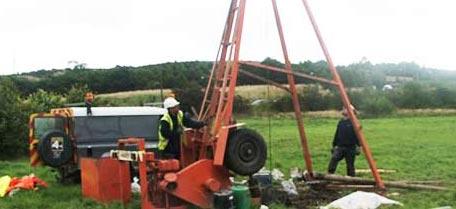What is a site investigation?
Before the engineer can design a foundation intelligently, he must have a reasonably accurate conception of the physical properties and arrangement of the underlying materials. The field and laboratory investigations required to obtain this essential information are called soil exploration or site investigation.

A site investigation simply is the process of the collection of information, the appraisal of data, assessment, and reporting without which the hazards in the ground beneath the site cannot be known.
Site investigation is carried out in order to enable a geotechnical and geoenvironmental assessment of the ground conditions and analysis of the engineering and environmental considerations related to the proposed development.
Purpose and Objectives of Site Investigation
In A Client's Guide to Site Investigation, the AGS states that adequate site investigation is of importance to the civil engineer for the successful completion of any building project,
The design of a structure which is economical and safe to construct, is durable and has low maintenance costs, depends upon an adequate understanding of the nature of the ground. This understanding comes from an appreciation of the distribution of the materials in the ground, and their properties and behaviour under various influences and constraints during the construction and lifetime of the structure. An adequate and properly structured site investigation is therefore an essential part of any civil engineering or building project.
{adselite} The primary objective of a site investigation is to determine as accurately as may be required-
- The nature and sequence of strata;
- The ground water conditions at the site;
- The physical properties of soil and rock underlying the site;
- The mechanical properties, such as strength and compressibility of different soil or rock strata, and
- Other specific information, when needed, such as the chemical composition of the groundwater, and the characteristics of foundations of the adjacent structure.
Site investigation should be organized to obtain all possible information toward a thorough understanding of the subsurface condition and probably foundation behavior.
Background Information before Subsurface Investigation
Before actual field investigation is started, the information should, whenever possible, be collected on:
- The type of structure to be built, its intended use;
- Characteristics of the structure;
- Starting date;
- Intended construction method;
- The estimated period of construction;
- The probable soil condition at the site, by geological, geotechnical or aerial analysis;
- The behavior of existing structures adjacent to the site, as well as other facts available through local experience.
The Extent of Soil Investigation
Subsurface condition at a site may be relatively uniform or extremely variable and will largely determine the complexity of the problems to be faced in both design and construction of the foundations. The subsurface investigation must, therefore, be of sufficient extent to provide enough information for a thorough understanding of the interaction of proposed foundations and supporting soil or rock on which to base a safe and economical design.
Depth of Site Investigation
The site investigation should be carried to such a depth that the entire zone of soil or rock affected by the changes caused by the building or the construction will be adequately explored. This may be taken as depth at which vertical stress induced by the new construction is smaller than 10% of the existing overburden stress at that level.
Where the depth of investigation cannot be related to background information, the following guidelines are suggested.
- It is good to have at least one boring carried to bedrock, or to well below the anticipated level of influence of the building.
- For light structures, insensitive to the settlement, the boring should be to a depth equal to four times the probable footing width or to a depth of 6m below the lowest part of the foundation, whichever is deeper.
- For more heavily loaded structures, such as multistory structures and for framed structures, at least 50% of the borings should be extended to a depth equal to 1.5 times the width of the building below the lowest part of the foundation, and
- Bedrock should be proved by coring into it to a minimum depth of 3m.
Stages of Site Investigation
The approach adopted for a particular site investigation, its extent and the techniques used will all depend upon the site-specific circumstances, and the experience and judgment of those involved. There is no single way to carry out an investigation, and inevitably different advisors will adopt different approaches for any particular project. However, it is usual for the site investigation to be a phased exercise.
For any project soil investigation is usually performed in several stages, i.e., during feasibility and planning stage, before construction and during construction (if required). These are termed as:
- Preliminary investigation;
- Detailed investigation;
- Supplementary investigation and construction control.
Preliminary Site Investigation
This phase includes gathering information such as the type of structure to be constructed and its future use, the requirements of local building codes, and the column and load bearing wall loads.
Considerable savings in the exploration program can sometimes be realized if the geotechnical engineer in charge of the project thoroughly reviews the existing information regarding the subsoil conditions at the site under consideration. Useful information can be obtained from the following sources.
- Geologic survey maps.
- County soil survey maps prepared by the U.S. Department of Agriculture and the soil conservation service.
- Soil manuals published by the state highway department.
- Existing soil exploration reports prepared for the construction of nearby structures.
- The engineer should visually inspect the site and the surrounding area. In many cases, the information gathered from such a trip is invaluable for future planning. The type of vegetation at a site may in some instances the type of subsoil that will be encountered. Open cuts near the site provide an indication about the subsoil stratification. Cracks in the existing wall of nearby structures may indicate settlement from the possible existence of soft clay layers or the presence of expansive clay soils.
Detailed Site Investigation
This phase consists of making several test borings at the site and collecting disturbed and undisturbed soil samples from various depths for visual observation and for laboratory tests. No hard and first rule exists for determining the number of borings or the depth to which the test boring is to be advanced. For most buildings, at least one boring at each corner and one at the center should provide a start. Depending on the uniformity of the subsoil, additional test borings may be made. The test borings should extend through unsuitable foundation materials to firm soil layers.
Supplementary Investigation and Construction Control
The following supplementary investigation is made to give a full picture of the site investigation of soil as well as the structure.
- Any special features such as the possibility of each quake or climatic factors such as flooding, seasonal swelling, and shrinkage, permafrost, or soil erosion.
- The availability and quality of local constructional materials such as concrete aggregates, building and road stone, and water for constructional purposes.
- For maritime or river structures information on normal spring and neap tide ranges, extreme high and low tidal ranges and river levels, seasonal river levels and discharges, the velocity of the tidal and river currents and other hydrographic and meteorological data.
- Results of laboratory tests on soil and rock samples appropriate to the particular foundation design or construction problems.
- Results of chemical analysis of soil, fill materials, and groundwater to determine possible deleterious effects on foundation structures.
- Results of chemical and bacteriological analysis of contaminated soils, fill materials and emissions to determine health hazard risks.
References
- Geotechnical & Geoenvironmental Site Investigation (October 2006)
- Association of Geotechnical and Geoenvironmental Specialists
- "Foundation Engineering"- Peck-Hanson-Thornburn
- RSA GEOTECHNICS LTD
Keywords:

